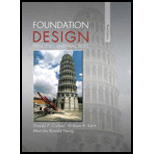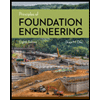
Foundation Design: Principles and Practices (3rd Edition)
3rd Edition
ISBN: 9780133411898
Author: Donald P. Coduto, William A. Kitch, Man-chu Ronald Yeung
Publisher: PEARSON
expand_more
expand_more
format_list_bulleted
Concept explainers
Textbook Question
Chapter 2, Problem 2.9QPP
We wish to design a shallow foundation with a probability of failure of
Expert Solution & Answer
Want to see the full answer?
Check out a sample textbook solution
Students have asked these similar questions
Problem 2. The square foundation shown in Figure below rests in homogeneous soft clay layer.
Subsurface exploration and laboratory testing found that the soil's effective cohesion is 30 kN/m².
The groundwater table is far below the ground surface and will not affect the bearing capacity. The
unit weight of clay above the groundwater table is 16.5 kN/m³. Using Terzaghi's bearing capacity
theory, determine the ultimate bearing capacity of the soil. Assume general shear failure. If the
factor of safety for bearing capacity is 3.5, calculate the allowable bearing capacity. B =1.2 m and
Df = 1.0 m.
Df
D₁
7
7 sat
B
Ground surface
Groundwater table
In the following example, a rectangular foundation must be designed whose B/L ratio must be equal to 0.5.The ultimate allowable load Qadm that must be transmitted to the ground is 520 KN, using a safety factor of 2.0. Designing with Meyerhoff theory, assume that the soil undergoes a general shear failure process. For this problem, propose values of B and L that meet the B/L ratio until Qadm is found to be equal to 520 kN.
Problem 1: A shallow foundation 25m × 18 m carries a uniform pressure of 175 kPa.
Determine the vertical stress at two points that are 12 m and 24 m below the mid-point of
one of the long sides, respectively.
(a) using influencing factors
(b) by means of Newmark's chart
(c) using the 2:1 method
(c) Comment on the results of the 2:1 method by comparing with those of the other
two methods.
Chapter 2 Solutions
Foundation Design: Principles and Practices (3rd Edition)
Ch. 2 - Classify the uncertainty associated with the...Ch. 2 - Figure 2.1 shows the PDF for a normal distribution...Ch. 2 - List three sources of epistemic uncertainty...Ch. 2 - Using a random number generator create a sample of...Ch. 2 - A certain column will carry a dead load estimated...Ch. 2 - A simply supported beam has a length of 3 m and...Ch. 2 - Using the data shown in Figure 2.5 determine the...Ch. 2 - The capacity for a certain foundation system is...Ch. 2 - We wish to design a shallow foundation with a...Ch. 2 - Prob. 2.10QPP
Knowledge Booster
Learn more about
Need a deep-dive on the concept behind this application? Look no further. Learn more about this topic, civil-engineering and related others by exploring similar questions and additional content below.Similar questions
- Figure 16.21 shows a continuous foundation with a width of 1.8 m constructed at a depth of 1.2 m in a granular soil. The footing is subjected to an eccentrically inclined loading with e = 0.3 m, and = 10. Determine the gross ultimate load, Qu(ei), that the footing can support using: a. Meyerhof (1963) method [Eq. (16.52)] b. Saran and Agarwal (1991) method [Eq. (16.53)] c. Patra et al. (2012) reduction factor method [Eq. (16.54)]arrow_forwardWe wish to design a shallow foundation with a probability of failure of 10-3 . The footingsupports a column carrying a dead load with a mean of 30 k and COV of 0.05 and a live loadwith a mean of 10 k and COV of 0.15. Based on the uncertainty of soil properties and our analysis method, we estimate the COV of the foundation capacity to be 0.2. For what mean cap-acity does the foundation need to be designed? Assume both loads and capacity are normally distributed.arrow_forwardA rectangle pad footing with dimension bx1 = 2mx2m is subjected to axial loading N^tt = 600 kN. Foundation are constructed on ground surface shown as Figure 1. The water table is at -1.5m. The average unit weight of mass between soil and concrete above of the bottom foundation is given tb = 22 kN/m3. The results of the test of the relationship between the pressure and void ratio is shown in table. Load factor n is given n = 1.15.arrow_forward
- Consider a continuous foundation of width B = 1.4 m on a sand deposit with c = 0, = 38, and = 17.5 kN/m3. The foundation is subjected to an eccentrically inclined load (see Figure 6.33). Given: load eccentricity e = 0.15 m, Df = 1 m, and load inclination = 18. Estimate the failure load Qu(ei) per unit length of the foundation a. for a partially compensated type of loading [Eq. (6.89)] b. for a reinforced type of loading [Eq. (6.90)]arrow_forwardA load of 800 Kip will be distributed on a circular foundation with a diameter of 20 feet, this structure will be located on the existing ground. The soil at the site has a unit weight of 105 lb/ft^3. Prepare a situation diagram to determine the vertical effective stress (lb/ft^2 no decimals) after building and loading the foundation at a point located: a) 12 feet below its center. b) 12 feet below its edge.arrow_forwardThe initial principal stresses at a certain depth in a clay soil are 100 kPa on the horizontal plane and 50 kPa on the vertical plane. Construction of a surface foundation induces additional stresses consisting of a vertical stress of 45 kPa, a lateral stress of 20 kPa, and a counterclockwise (with respect to the horizontal plane) shear stressof 40 kPa. Determine the change in orientation of the principal plane resulting from the construction of foundation. CHOICES ( WITH COMPLETE SOLUTION): a. principal stress plane rotates 23 degree counterclockwise from horizontal plane b. principal stress plane rotates 46 degree clockwise from horizontal plane c. principal stress plane rotates 23 degree clockwise from horizontal plane d. principal stress plane rotates 46 degree counterclockwise from horizontal planearrow_forward
- A flexible foundation is 2 m x 4 m rests on granular soil at ground level. It carries a uniformly distributed load of 160 kN/m2. The sand has an elastic modulus of 39 MPa , a Poisson's Ratio of 0.3 and is 5 m thick. Estimate the elastic settlement below the center of the loaded foundation. Give your answer in cm rounded to 2 decimal places.arrow_forwardThe concentrically loaded square foundation with dimensions of 2.0mx 2.0m, shown in the given figure, sits in a layer of sand 1m deep from the soil surface. The modulus of elasticity, Es and unit deformation impact factor, Iz values for the sand layer under the foundation base are given in the figure. The groundwater level is 1 m deep at the base of the foundation. Using the Schmertmann formula under the foundation, calculate the elastic settlement value that can occur in the sand within 5 years. Which of the following is the elastic settlement value you have found in mm.arrow_forwardThe figure below shows a proposed foundation site, with 10 ft of sand overlying 20 ft of clay with consolidation properties shown. The clay is normally consolidated. Assume 1-D conditions.a. Compute the initial σ′v at the middle of the clay layer prior to excavation and constructionb. After excavation and during construction, the foundation area will be heavily loaded with the structure and equipment so that σ′v at the middle of the clay layer will be increased to 3900 psf. Determine the settlement that will occur under these conditionsc. After construction is completed, the equipment will be removed and the final σ′v at the middle of the clay layer will be 3200 psf. Compute the swell that occurs after the equipment is removedarrow_forward
- A square foundation measuring 2 x 2 m2 is located above ground level and carries a load of 50kN. The modulus of elasticity and Poisson's Ratio of the soil under the foundation are 40 mPa and 0.3, respectively. As a result of this load the soil under the foundation will experience an elastic decline. The thickness of the soil layer that is taken into account in determining this settlement Pavg 1,1, to calculate the 1- v is 10 meters. The shape factor used in the formula sę = q(aB') (Es)avg elastic settlement at the corner of the foundation is... А. 0.455 В. О.437 C. 0.031 D. there are no right answerarrow_forwardA ground investigation report shows that the foundation of a proposed structure is to be founded at 1.2m below the surface of a saturated clay, and laboratory tests conducted on representative samples established the following soil parameters; pu = 0°, cu = 24 kPa; ' = 25°, and c' = 0. The unit weight of the clay is 20 kN/m³. Assuming a square footing has been proposed, and the footing is expected to support a concrete column with dimensions of 0.35m x 0.35m x 4.1m, carrying an axial load of 88P kN excluding self-weight. Where P = 8. Take unit weight of concrete as 24 kN/m³. Propose a suitable foundation size for the following conditions; (a) Immediately after construction (short term condition) (b) Some years after construction (long term condition) Use Terzaghi's bearing capacity theory, and take the factor of safety for bearing capacity as 3.0. Assume a foundation slab thickness of 0.3m. Table Q1 shows bearing capacity factors for general failure mode.arrow_forwardThe 6m x 9m rectangular foundation shown carries a uniform load of 325 kPa. Using NEWMARK'S influence chart, solve for the stress increase at point A. The answer must be 140.4 . Please show solutionarrow_forward
arrow_back_ios
SEE MORE QUESTIONS
arrow_forward_ios
Recommended textbooks for you
 Principles of Foundation Engineering (MindTap Cou...Civil EngineeringISBN:9781337705028Author:Braja M. Das, Nagaratnam SivakuganPublisher:Cengage Learning
Principles of Foundation Engineering (MindTap Cou...Civil EngineeringISBN:9781337705028Author:Braja M. Das, Nagaratnam SivakuganPublisher:Cengage Learning Principles of Foundation Engineering (MindTap Cou...Civil EngineeringISBN:9781305081550Author:Braja M. DasPublisher:Cengage Learning
Principles of Foundation Engineering (MindTap Cou...Civil EngineeringISBN:9781305081550Author:Braja M. DasPublisher:Cengage Learning Fundamentals of Geotechnical Engineering (MindTap...Civil EngineeringISBN:9781305635180Author:Braja M. Das, Nagaratnam SivakuganPublisher:Cengage Learning
Fundamentals of Geotechnical Engineering (MindTap...Civil EngineeringISBN:9781305635180Author:Braja M. Das, Nagaratnam SivakuganPublisher:Cengage Learning Principles of Geotechnical Engineering (MindTap C...Civil EngineeringISBN:9781305970939Author:Braja M. Das, Khaled SobhanPublisher:Cengage Learning
Principles of Geotechnical Engineering (MindTap C...Civil EngineeringISBN:9781305970939Author:Braja M. Das, Khaled SobhanPublisher:Cengage Learning

Principles of Foundation Engineering (MindTap Cou...
Civil Engineering
ISBN:9781337705028
Author:Braja M. Das, Nagaratnam Sivakugan
Publisher:Cengage Learning

Principles of Foundation Engineering (MindTap Cou...
Civil Engineering
ISBN:9781305081550
Author:Braja M. Das
Publisher:Cengage Learning

Fundamentals of Geotechnical Engineering (MindTap...
Civil Engineering
ISBN:9781305635180
Author:Braja M. Das, Nagaratnam Sivakugan
Publisher:Cengage Learning

Principles of Geotechnical Engineering (MindTap C...
Civil Engineering
ISBN:9781305970939
Author:Braja M. Das, Khaled Sobhan
Publisher:Cengage Learning
CE 414 Lecture 02: LRFD Load Combinations (2021.01.22); Author: Gregory Michaelson;https://www.youtube.com/watch?v=6npEyQ-2T5w;License: Standard Youtube License